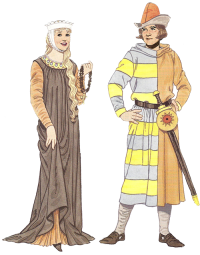In the solar 510

Clothing shifts from 5th- or 6th-Century dress to later medieval fashions. Thick leather shoes are common.
Men’s fashion in 510
Fashion for men is becoming a thing, and it's becoming more and more important to dress correctly at the court. The ideal at the moment is the strong-headed Hervis the Revel, who prefers knotted cloaks.
Latest trends in men's clothing:
Men wear both a long-sleeved undertunic and an overtunic of fine wool or linen. The overtunic has no sleeves, and is fastened at the waist by a belt. Legs are covered with chausses, which are thick stockings.
Latest trends in men's hairstyles:
Hair cuts are short, with a soup-bowl style being popular among knights, in part because it suits the type of helmets being worn. Men are clean-shaven.
Women’s fashion in 510
Ygraine has long been the ideal of fashion, but new trends from the continent is becoming stronger. Currently there is a trend of dressing in blue long dresses, similar to the beutiful Margawse.
Latest trends in women's clothing:
Men wear both a long-sleeved undertunic and an overtunic of fine wool or linen. The overtunic has no sleeves, and is fastened at the waist by a belt. Legs are covered with chausses, which are thick stockings.
Latest trends in women's hairstyles:
Unmarried women still has their hair let out, and married women use white silken haircovers, in increasingly complicated arrangements.
Fashion in the Boy King Period
“Fashion” is seriously becoming a concept. The latest trends from Arthur’s court is spreading across the land, the quicker you adapt the more status you get. Buttons does not exist yet, neither does buckles. Clothes are fastened with strings, hooks or threads. This makes getting dressed a time-consuming process.Clothes from this period go out of fashion every year.
Clothing during this Period shifts from 5th- or 6th-Century dress to later medieval fashions.
Cymric Fashion in the Boy King Period
Men wear both a long-sleeved undertunic and an overtunic of fine wool or linen. The overtunic has usually have no sleeves, and is fastened at the waist by a belt. Legs are covered with chausses, which are thick stockings. Thick leather shoes are common. The cloak is notted and pinned at the right shoulder. Hair cuts are short, with a soup-bowl style being popular among knights, in part because it suits the type of helmets being worn. Men are clean-shaven.
Women wear sleeved undertunics like a man’s. The overtunic, called a bliant, fits tightly at the waist and flows into a skirt. The neck is cut low to reveal the undertunic beneath and is laced up the sides. Belts are worn around the waist, and the cloak is attached with a cord across the neck.
